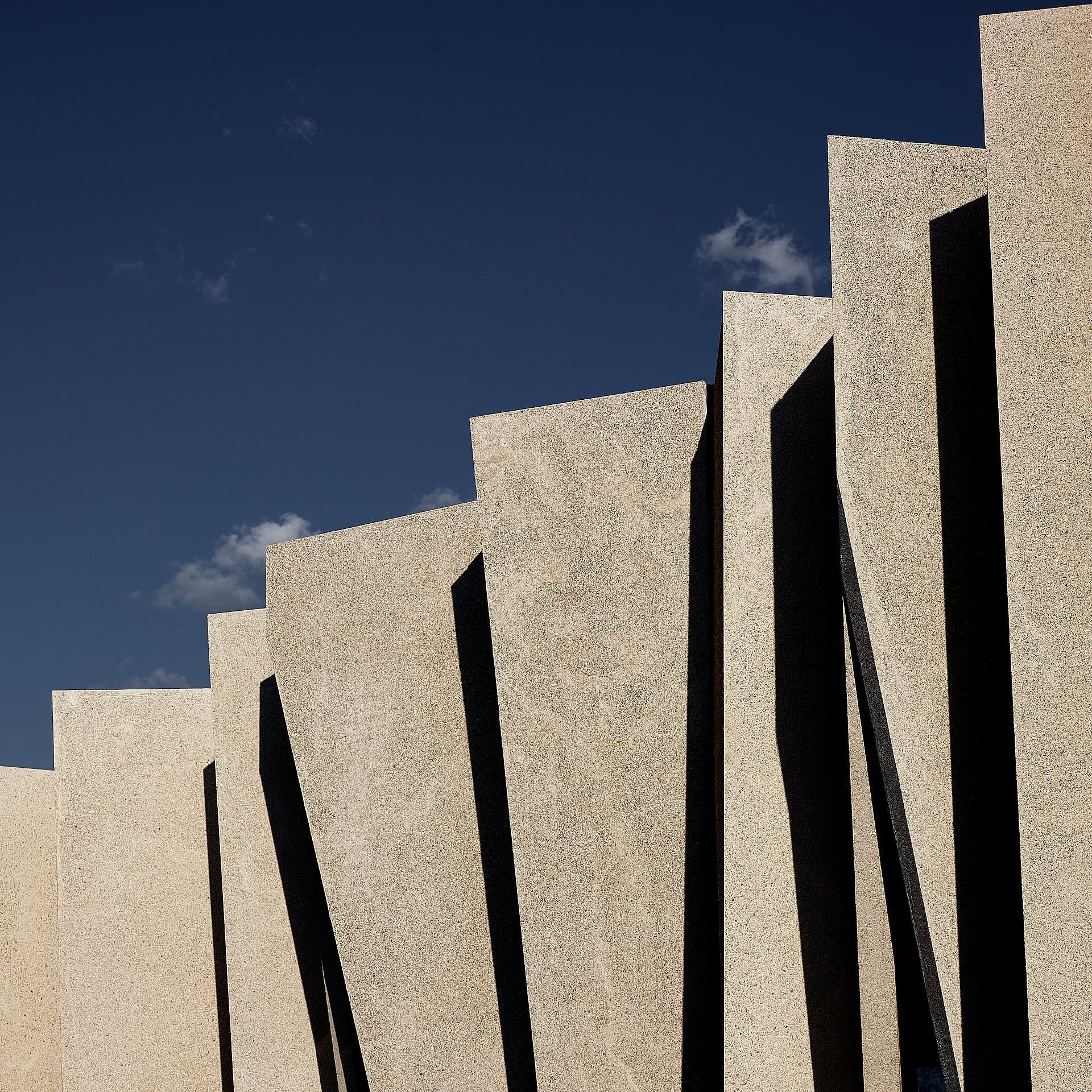
Kellerei Kurtatsch
Location Kurtatsch, South Tyrol, Italy Architect dell'angolo kelderer Architekten Completed 2017 Cost Approx. 6.5 million
In the vast South Tyrolean Alpine region of Kurtatsch, an architectural marvel emerges, seemingly part of the earth's crust itself. The Kurtatsch winery has been part of this fragile yet demanding landscape for over 120 years. When dell’agnolo kelderer Architects was commissioned to expand the winery, it was essential to showcase the Kurtatsch winery as part of the culture of the surrounding historical Alpine architecture and its interweaving with the terroir. As a photographer, I also faced this challenge for the photo series.
To photograph the new mountain-like dolomite facade of the sales room in connection with the existing architecture and the landscape to which it is bound, I had to employ a range of techniques to represent the mood and inviting atmosphere of the winery and the relationship between the building and its location. The challenging terrain and complex perspectives required my skills as a drone pilot for aerial photography. Photographing the winery itself during normal operating hours required patience, logistics, and sensitivity. Knowledge of lighting, visual hierarchy, and color was essential to create seductive images of the dark, atmospheric cellar.
The result is a series of images that convey a sense of place and tell the beautiful and rare story of 190 family businesses working together as one winery, dedicated to the materials, light, weather, harvest, and hospitality of the land.
A perfect example of modern Alpine architecture
Our legs were still aching from the long descent from the Neue Schwarzensteinhütte when my assistant Marcus and I set off in the early afternoon for our next architectural shoot for the Modern Alpine Architecture series. Nestled among the seemingly endless rows of orchards and vineyards, halfway up the slope of the Etschtal valley, lies the Kurtatsch winery. Approaching from the east, we saw the inconspicuous old building of the winery, which from this direction gives no indication of its architectural transformation on the west facade of the building. The stone concrete facade rises like a mountain from the visitor parking lot into the warm summer air. It was this perspective that immediately captivated me. The hard, straight edges remind me of my favorite climbing walls in the nearby Dolomites: Majestic, natural, and powerful.
The stone concrete facade in the shape of a mountain range has enchanted me.
Photographing the complex exterior of the Kurtatsch winery
To emphasize the rigid and graphic facade, I planned the shot to utilize the harsh sunlight to create clearly defined shadows. This bold interplay of light and darkness helped to accentuate the angular shapes and showcase the depth of the staggered, mountain-like projections.
The connection between the vines and the winery is evident in every image, thus reinforcing the architect's conceptual claim to integrate nature into the building.

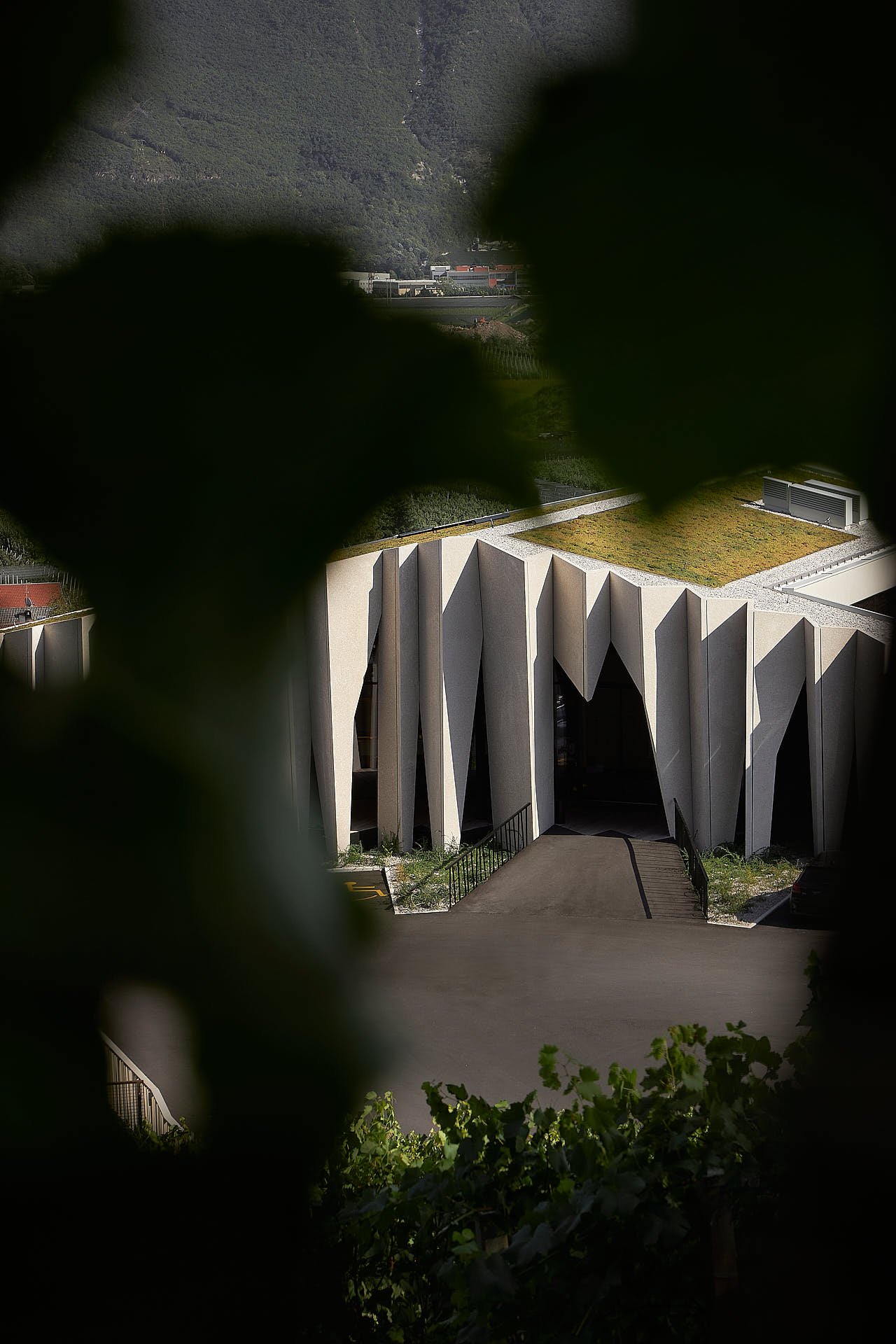
During the design process, dell’agnolo kelderer Architects had carefully considered that the majority of the facade had to be kept simple and tasteful so as not to detract from the historical, regional architecture and the charm of the area. For the photos, it was important to show the relationship between the winery and the local buildings and properties. Aerial shots give us the perfect perspective to capture the building's relationship to its surroundings. As viewers, we find ourselves in this wonderful landscape and can capture the entire surroundings in one image. This view shows the entire Kurtatsch winery in the Etschtal valley. The drone shot allows me to show the building free of trees, houses, and traffic signs. This view would have been impossible from the ground.
The drone images show how the old winery roof blends seamlessly into the surrounding structures and the new architecture. The roofs are directly illuminated, which highlights the shapes and geometry of the facade. The long shadows in the aerial shots harmonize with the mood of the exterior shots from the ground.


Photographing the hospitable interior of the winery
As we walk through the portal made of folded concrete slabs onto the veranda, the mood of the building changes completely. Warm wood envelops us. Generous, unbroken lines of sight give us a wide view of the valley and the Alps behind. The sales area of the winery is framed with large, custom-made glass elements. They seem to make the boundary between inside and outside disappear and invite the viewer to explore the building further. Protected from the burning summer sun, we enjoy the light breeze coming from the veranda opening on the valley side. Despite the airy ceiling height and the many glass elements, there is a feeling of security and protection here. As if from a protective cave, I look through the many openings in the concrete facade, which from the outside could not be distinguished from the shadows of the rock formations.

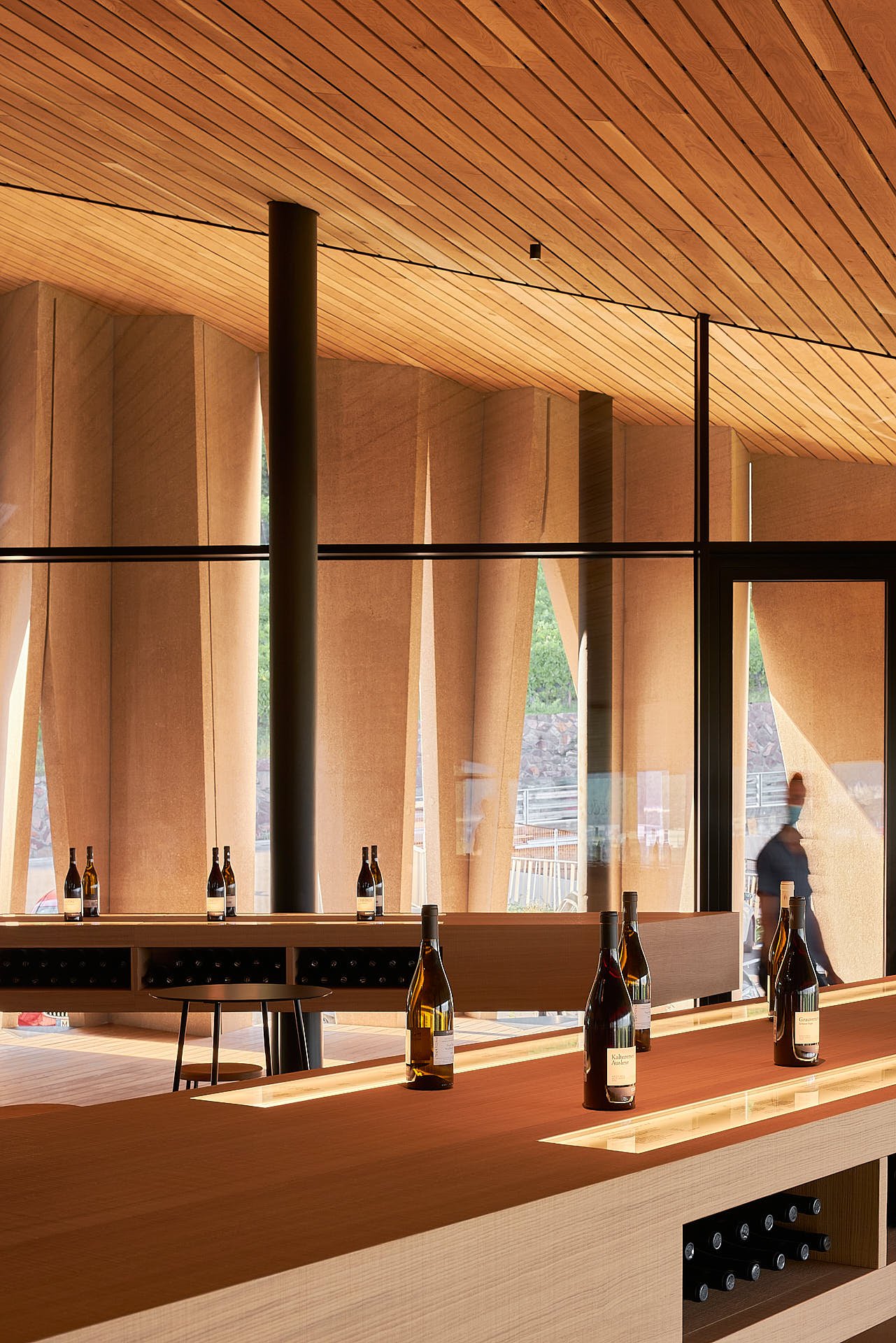
In my image compositions, I focused on the enormous glass elements. The windows, produced by the metalworking company Metall Ritten in Klobenstein, open up endless views of the nature surrounding the winery. We see how light enters through every thin opening. The light shines through the windows and is reflected in warm tones through the many wooden elements. In my image composition, I used the reflective quality of the glass to point to the beautiful facade, even if it is not the focus of the image. The mixture of playful directional light and warm tones creates an inviting atmosphere that draws us into the Kurtatsch winery and allows us to imagine what it is like to linger there and taste the aromatic white wines of the winery.
Grandiose atmosphere in the wine cellar
As we descend into the rock cellar, we can explore the sustainable design of dell’agnolo kelderer Architects and the carefully considered textures and materials that were selected to unite the building structure and its surroundings. The architect Egon Kelderer explains: "We used the geological formations of the rock walls for the design of the rooms. This saves resources on the one hand and minimizes the disturbance of natural structures. On the other hand, the rock wall is also used as part of the architecture. It creates a connection to the natural process of winemaking. After all, many of the minerals in the soil and rock are also contained in the wines of the winery."
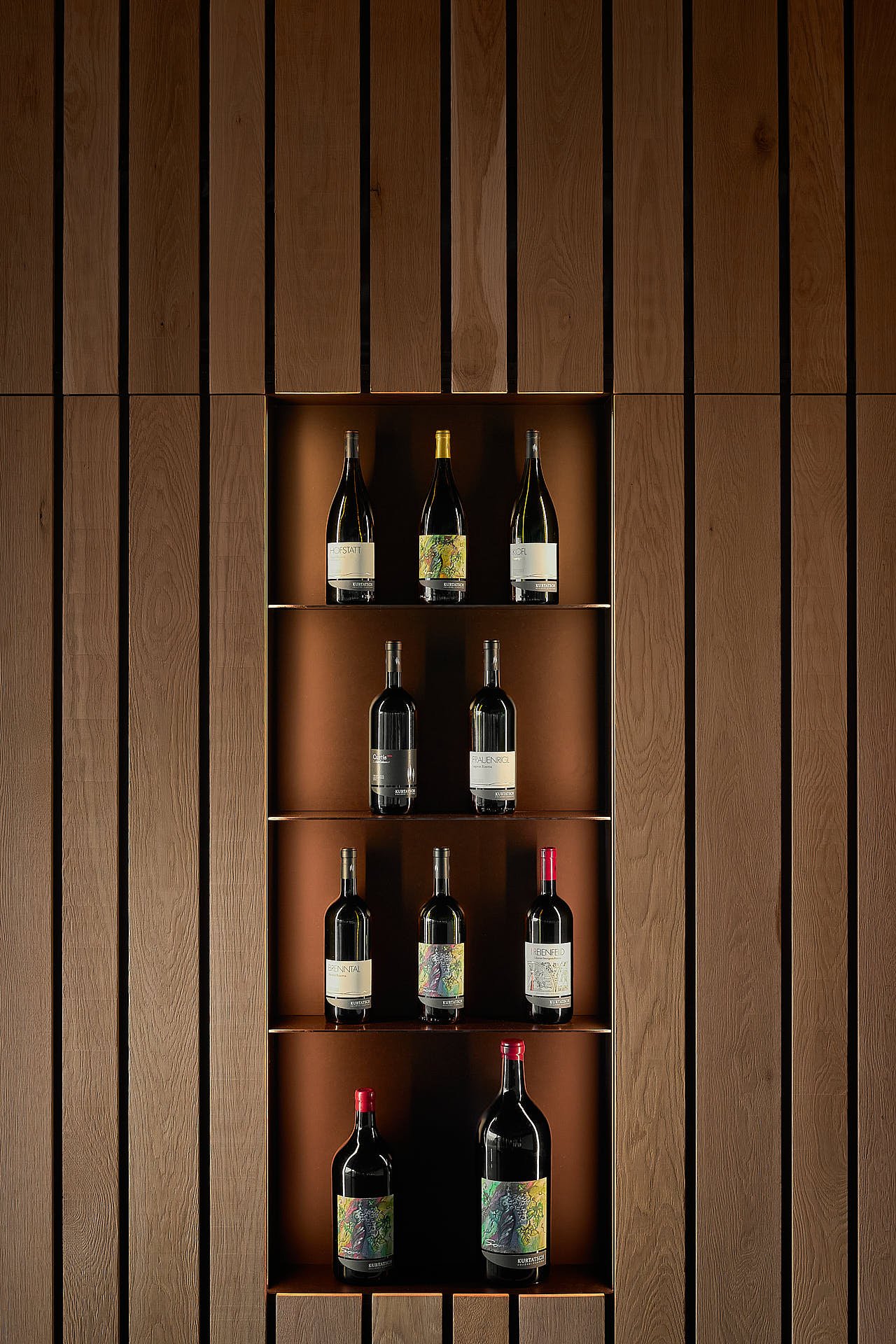
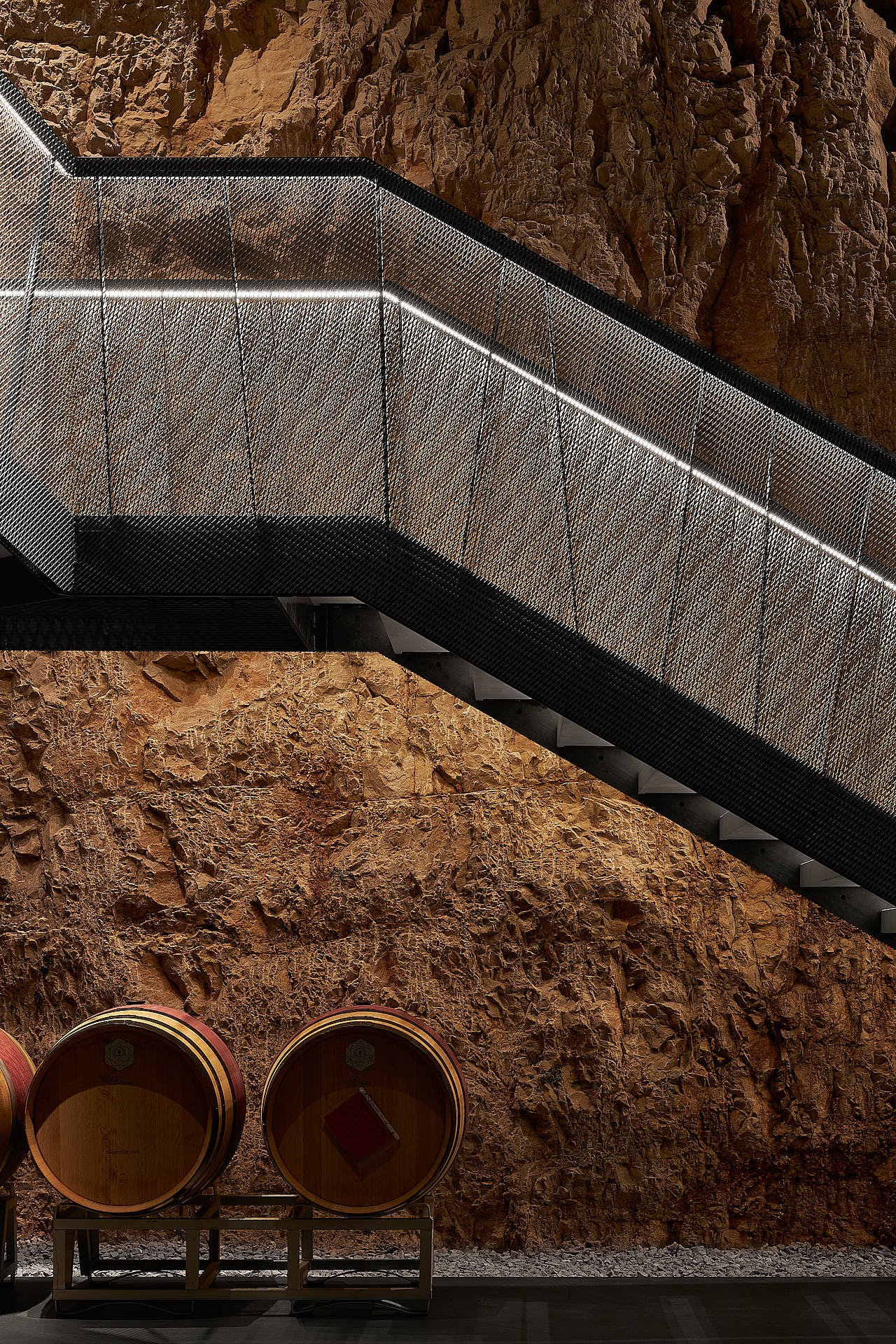
Kurtatsch Winery and Tyrol in the Twilight
In architectural photography, twilight shots are often the hero images. Standing in front of the Kurtatsch Winery and photographing it in the evening twilight, it's easy to see why. After the harsh sunlight of the day has passed, new shadows appear on the mountain-like facade. The warm yellow light draws our eyes and contrasts perfectly with the dark blue sky above Tyrol. In the background, we catch a glimpse of the mountain ranges of the Etschtal valley in the last light of the day. The modern design of the facade creates a beautiful rhythm that allows our eyes to wander through the frames of the glass and stone walls, eventually resting on the horizon in the background.
The veranda glows with light, appearing as a warm beacon against the night sky. The alternating triangles of warm and cool colors emphasize the mountain peak-inspired design that surrounds this wine oasis. There is an inviting and intimate feeling here that perfectly suits the location.

When we step back onto the veranda in the evening this time, we are greeted with another fantastic view of the Etschtal valley. It was important to me to capture as much of the atmosphere in this space as possible. It conveys a feeling of warmth through the glow of the facade lights against the coolness of the night sky. Again, we see the same shapes and reflections of the facade in the glazing. This connects the entire photographic composition and conveys a sense of continuity throughout the project.
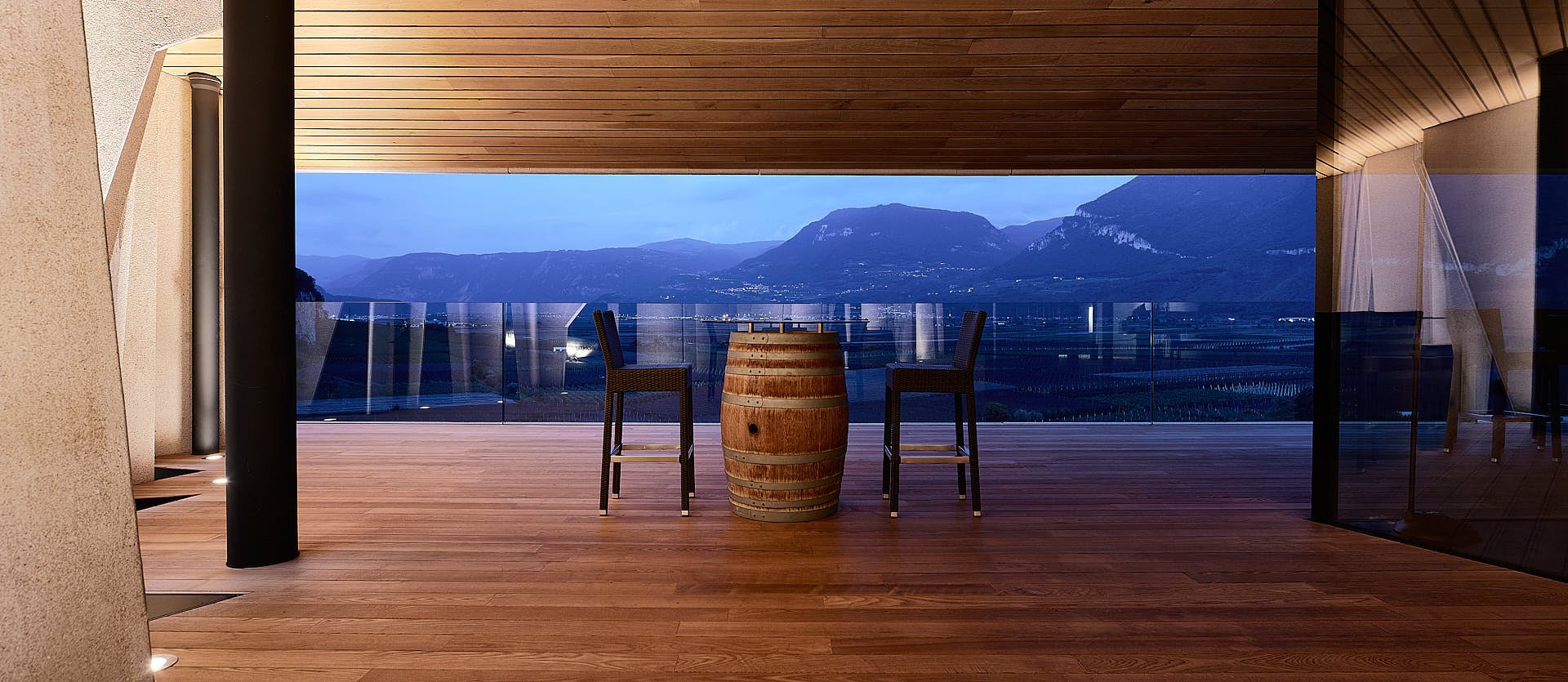
An Architectural Sculpture of the Alps
As someone with a passion for architecture, photography, and alpine lifestyle sports like climbing and snowboarding, this project holds a piece of my heart. The winery not only reflects and honors the natural world – and culture – that surrounds it, but is also a shrine to the great achievements of architecture and engineering. Amazingly, such an intricate and beautiful structure can respectfully exist in this fragile landscape. The modern architecture of the Kurtatsch Winery amidst the rugged Tyrolean terrain makes it a modern sculpture of the Alps.
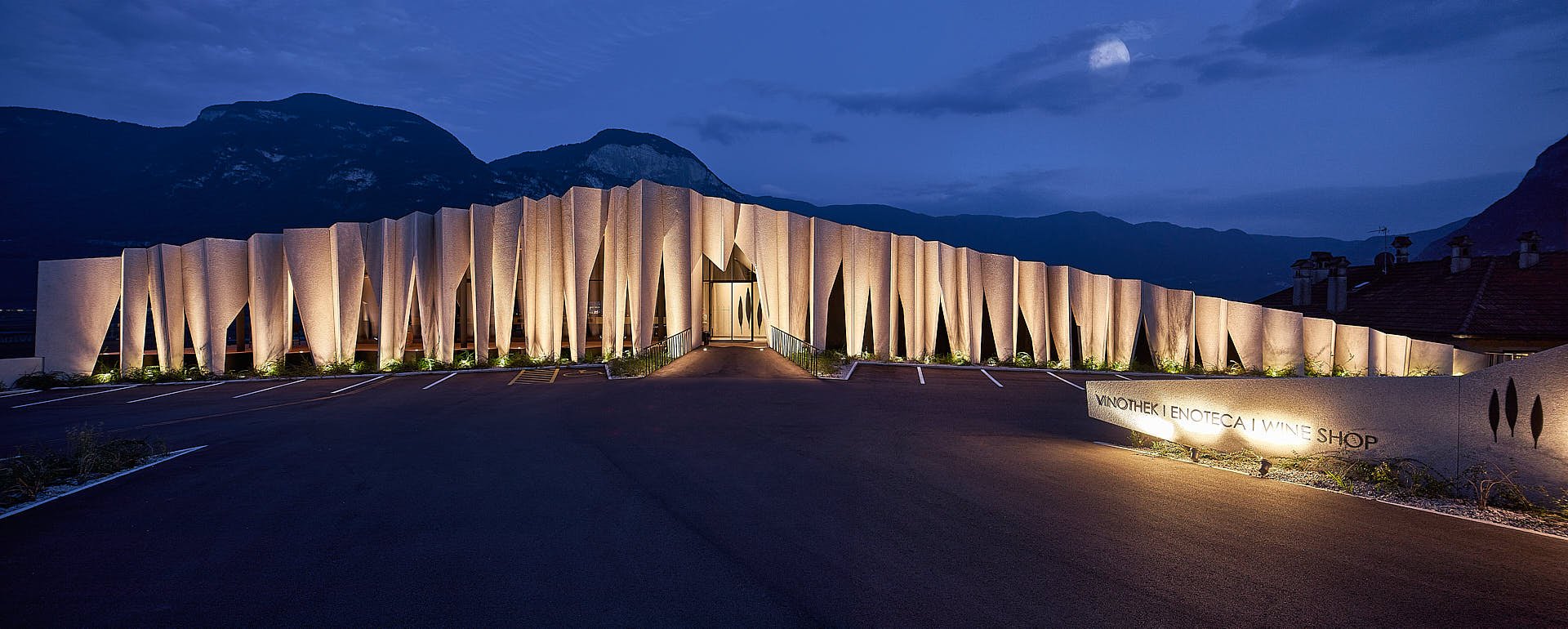
Image Editing
Photographing the cellar was a challenge. The lack of natural light and sparsely placed practical lights created a dark environment that was beautiful and atmospheric in real life, but not so easy to capture with the camera. The large disparity in exposure between the black ceiling and the illuminated concrete elements created an abundance of contrasts and inaccurate colors that I had to pay close attention to. Through targeted local brightness adjustments in post-processing, the viewer is guided to the most important point of the image, the staircase. It is the brightest point with the most structures. With the right concept, image editing becomes an essential part of my architectural photography.
Equipment
Camera
1. Lens
2. Lens
3. Lens
Tripod
Software
Canon EOS R.
Canon TS-E 24 mm 1:3.5 l II
Canon EF 50 mm 1:1.2 l USM
Canon RF 24-105MM F4L IST USM
Feisol CT-3441T Rapid
Capture One 21, Adobe Photoshop CC










